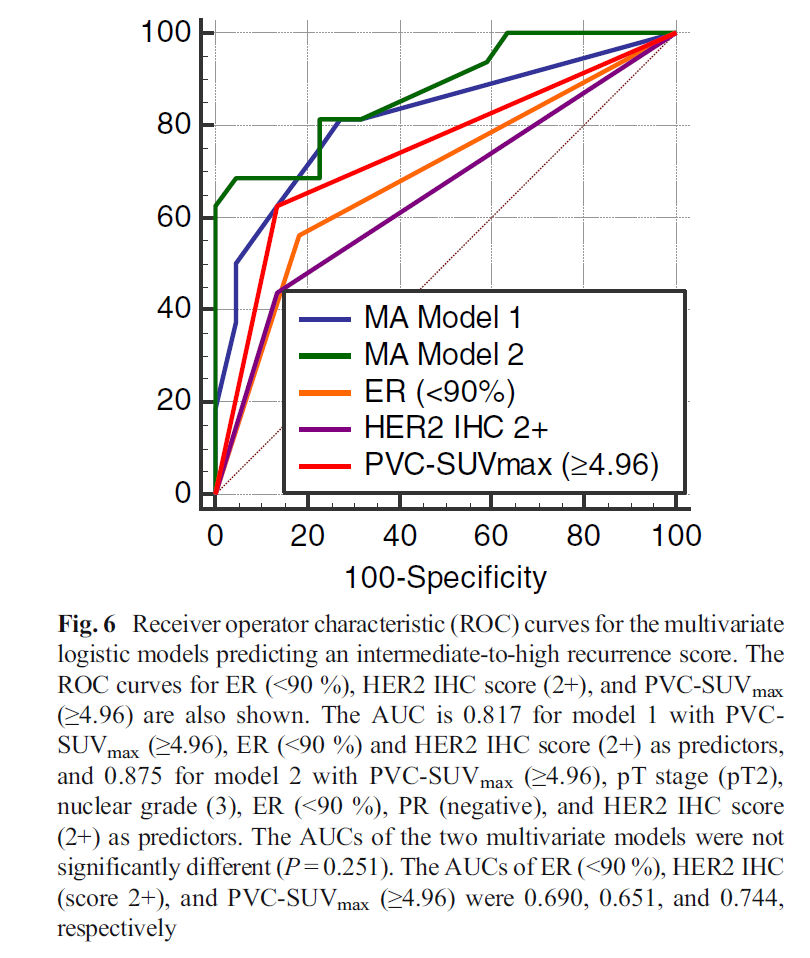글로벌 연구동향
방사선생물학
![[Eur J Nucl Med Mol Imaging.] Association between partial-volume corrected SUVmax and Oncotype DX recurrence score in early-stage, ER-positive/HER2-negative invasive breast cancer.](/enewspaper/upimages/admin_20160608095805_R.jpg) 2016년 06월호
2016년 06월호
[Eur J Nucl Med Mol Imaging.] Association between partial-volume corrected SUVmax and Oncotype DX recurrence score in early-stage, ER-positive/HER2-negative invasive breast cancer.서울의대/ 이수현,하승균,문우경*,천기정*
- 출처
- Eur J Nucl Med Mol Imaging.
- 등재일
- 2016 May 21
- 저널이슈번호
- 내용

AbstractPURPOSE:
Oncotype DX, a 21-gene expression assay, provides a recurrence score (RS) which predicts prognosis and the benefit from adjuvant chemotherapy in patients with early-stage, estrogen receptor-positive (ER-positive), and human epidermal growth factor receptor 2-negative (HER2-negative) invasive breast cancer. However, Oncotype DX tests are expensive and not readily available in all institutions. The purpose of this study was to investigate whether metabolic parameters on 18F-FDG PET/CT are associated with the Oncotype DX RS and whether 18F-FDG PET/CT can be used to predict the Oncotype DX RS.
METHODS:
The study group comprised 38 women with stage I/II, ER-positive/HER2-negative invasive breast cancer who underwent pretreatment 18F-FDG PET/CT and Oncotype DX testing. On PET/CT, maximum (SUVmax) and average standardized uptake values, metabolic tumor volume, and total lesion glycolysis were measured. Partial volume-corrected SUVmax (PVC-SUVmax) determined using the recovery coefficient method was also evaluated. Oncotype DX RS (0 - 100) was categorized as low (<18), intermediate (18 - 30), or high (≥31). The associations between metabolic parameters and RS were analyzed. Multivariate logistic regression was used to identify significant independent predictors of low versus intermediate-to-high RS.
RESULTS:
Of the 38 patients, 22 (58 %) had a low RS, 13 (34 %) had an intermediate RS, and 3 (8 %) had a high RS. In the analysis with 38 index tumors, PVC-SUVmax was higher in tumors in patients with intermediate-to-high RS than in those with low RS (5.68 vs. 4.06; P = 0.067, marginally significant). High PVC-SUVmax (≥4.96) was significantly associated with intermediate-to-high RS (odds ratio, OR, 10.556; P = 0.004) in univariate analysis. In multivariate analysis with clinicopathologic factors, PVC-SUVmax ≥4.96 (OR 8.459; P = 0.013) was a significant independent predictor of intermediate-to-high RS.
CONCLUSIONS:
High PVC-SUVmax on 18F-FDG PET/CT was significantly associated with an intermediate-to-high Oncotype DX RS. PVC metabolic parameters on 18F-FDG PET/CT can be used to predict the Oncotype DX RS in patients with early-stage, ER-positive/HER2-negative breast cancer.
Author information
Lee SH1, Ha S2,3, An HJ2,4, Lee JS2,4, Han W5, Im SA6, Ryu HS7, Kim WH8, Chang JM1, Cho N1, Moon WK9,10,11, Cheon GJ12,13,14.
1Department of Radiology, Seoul National University Hospital, Seoul National University College of Medicine, Seoul, South Korea.
2Department of Nuclear Medicine, Seoul National University Hospital, Seoul National University College of Medicine, Seoul, South Korea.
3Department of Molecular Medicine and Biopharmaceutical Sciences, Graduate School of Convergence Science and Technology, and College of Medicine or College of Pharmacy, Seoul National University, Seoul, South Korea.
4Department of Biomedical Sciences, Seoul National University College of Medicine, Seoul, South Korea.
5Department of Surgery, Seoul National University Hospital, Seoul National University College of Medicine, Seoul, South Korea.
6Department of Internal Medicine, Seoul National University Hospital, Seoul National University College of Medicine, Seoul, South Korea.
7Department of Pathology, Seoul National University Hospital, Seoul National University College of Medicine, Seoul, South Korea.
8Department of Radiology, Kyungpook National University Hospital, Daegu, South Korea.
9Department of Radiology, Seoul National University Hospital, Seoul National University College of Medicine, Seoul, South Korea. moonwk@snu.ac.kr.
10Cancer Research Institute, Seoul National University College of Medicine, Seoul, South Korea. moonwk@snu.ac.kr.
11Radiation Medicine Research Institute, Seoul National University College of Medicine, Seoul, South Korea. moonwk@snu.ac.kr.
12Department of Nuclear Medicine, Seoul National University Hospital, Seoul National University College of Medicine, Seoul, South Korea. larrycheon@gmail.com.
13Cancer Research Institute, Seoul National University College of Medicine, Seoul, South Korea. larrycheon@gmail.com.
14Radiation Medicine Research Institute, Seoul National University College of Medicine, Seoul, South Korea. larrycheon@gmail.com.
- 키워드
- 18F-FDG PET/CT; Breast cancer; Oncotype DX; Oncotype DX recurrence score; Partial volume correction; Recovery coefficient
- 연구소개
- Oncotype DX recurrence score (RS) 는 조기 유방암 환자에서 종양조직의 21개 유전자 발현 정보를 바탕으로 재발 예후 예측에 유용성이 입증된 검사입니다. Oncotype DX의 주요한 대상군이 크기가 작은 종양이기에 그간 FDG PET/CT를 이용한 관련 연구에 partial volume 효과 등에 따른 제한점이 있었습니다. 본 논문에서는 Recovery Coefficient 방법을 이용하여 Partial-volume 효과를 교정함으로써 제한점을 극복하였습니다. 본 연구 결과에 따르면 Partial-volume corrected (PVC)-SUVmax가 4.96 g/mL보다 높은 경우에 intermediate-to-high Oncotype DX RS를 잘 예측할 수 있으며 이는 ER 또는 HER2 등등의 조직학적 파라미터와는 독립적인 것을 확인할 수 있습니다.
- 덧글달기
- 이전글 [PLoS One.] Induction of MiR-21 by Stereotactic Body Radiotherapy Contributes to the Pulmonary Fibrotic Response.
- 다음글 [Cancer Res Treat.] Comparison of Total Body Irradiation (TBI) Conditioning with non-TBI for Autologous Stem Cell Transplantation in Newly Diagnosed or Relapsed Mature T and NK-cell Non-Hodgkin Lymphoma.







